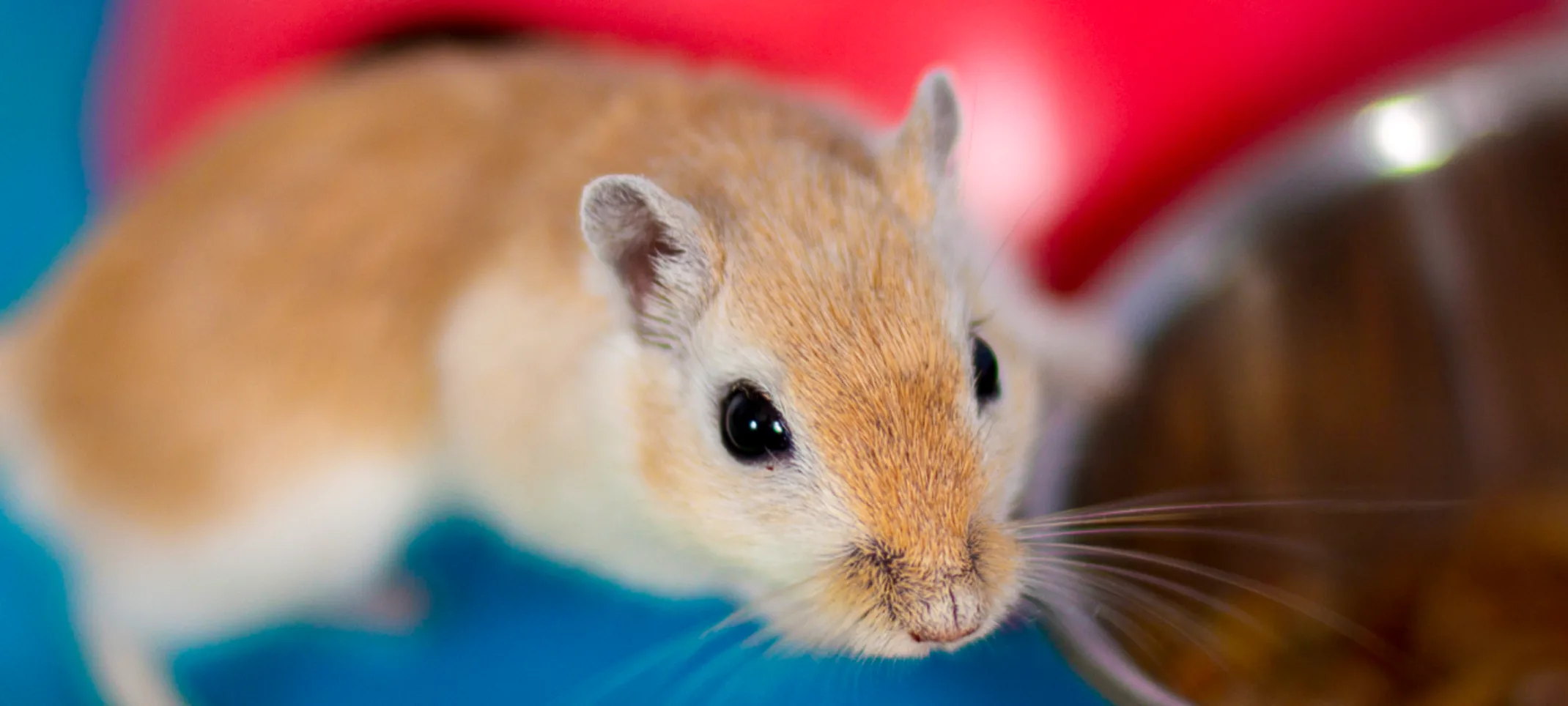I-20 Animal Medical Center
Gerbil Husbandry
Gerbils make good pets because of their small size, easy maintenance and their hardiness.

Gerbils make good pets because of their small size, easy maintenance and their hardiness. Most pet gerbils are inquisitive but nervous at first. Gerbils are nocturnal, meaning they are most active at night and in the evening hours. Gerbils should be kept alone in a cage and should not be housed together due to issues with fighting and aggression. The exception is gerbils that were raised together when still young; then they are usually tolerant of each other as long as the cage is big enough. Gerbils weigh around 50-100 grams depending on the species. Male gerbils tend to be larger than females. Gerbils live on average 3-4 years.
Getting to Know Your New Gerbil
When you first get a new gerbil as a pet, gentle handling is necessary and you need to move at a pace that your gerbil finds comfortable. Too much handling too soon (before your gerbil gets to know you) can cause stress. Handling in the evening hours is best because that is when your gerbil will be most active. Gerbils can be nippy when first awakened or with sudden movements, and will dart and jump away when frightened, so make sure to go slow. The best way to pick up your gerbil is to gently scoop them up in your hands. NEVER pick your gerbil up by the tail because this can cause serious injury to your gerbil. Because they are small and quick, handling by smaller children can be dangerous for the gerbil and is not recommended. Treats can be used as positive reinforcement for getting your gerbil used to being handled. Improper handling or overly aggressive handling will result in painful bites.
Housing
A safe, well ventilated cage is necessary for your gerbil’s health. Commercial rodent cages are acceptable. Cages should be at least 12” high and with a closed top to prevent escape. The general rule is the larger the better! Cages with multiple levels allow gerbils to explore and exercise. Plastic, stainless steel or glass cages are more common. Aquarium-style terrariums should be avoided because there is a risk of having poor ventilation and respiratory problems if not kept immaculately clean. Flooring should be solid to avoid trapped toes and foot-pad injuries. If the cage sides are wire mesh, it is important to make sure the mesh is small enough that toes and legs cannot get stuck in the mesh squares.
Gerbils are notorious for escaping from cages, and this can cause harm if they are loose in the house with dogs or cats, or get access to electrical wires. Gerbils should have multiple places to hide and explore in the cage; hide boxes, climbing tunnels, PVC piping, and offering other commercial toys are all great options. Gerbils also enjoy a running wheel. Just make sure the wheel has a solid running surface, not open squares, because toes can get caught in the squares and cause injuries. Gerbil balls can be used to exercise your gerbil outside of the cage, but be careful to closely monitor your gerbil during this exercise time. Exercise balls can roll down stairs, be chewed on by other pets, and can get overheated in direct sunlight.
Substrate
We only recommend using recycled newspaper or paper products, such as Carefresh bedding, in your gerbil’s cage. Natural beddings (cedar, pine, aspen, and wood chips or shavings) have a tendency to grow microorganisms like bacteria and fungi, even when cleaned appropriately and often. They also can create dust that can cause allergies in both the gerbils and their people. Respiratory diseases are common in gerbils, and those that are housed on natural beddings are at an increased risk for problems. Bedding should be at least 1” deep to allow your gerbil to burrow, which is a natural and desirable behavior. Change the substrate once a week.
Nutrition
Gerbils should be fed a commercially available pelleted diet or rodent block. Ideal brands of food include Oxbow or Kaytee pellets. Avoid purchasing bags that offer a seed and pellet mixture – the gerbils will simply eat all the seeds and leave the healthier food behind! The pellets can be offered free choice (usually a ceramic dish is preferred because it is heavier and won’t spill over as easily, or a feeding hopper is also a great choice). Treats should be limited and can include some fresh vegetables, occasional seeds and nuts, or dried fruits like raisins.
Gerbils have cheek pouches where they can store food, so it is not uncommon for you to see your gerbil stuff his face with food and go off into his hideaway to finish dinner! Water should always be available to your gerbils and should be offered from a cage sipper bottle. Fresh water should be given each day. Make sure to thoroughly clean the water bottle and food dishes regularly to avoid bacterial buildup. Hot water and dish soap can be used to clean the dishes; just make sure and rinse them thoroughly.
Medical Care
New pet gerbils should be examined within the first week to look for any signs of illness and intestinal parasites. Bring your gerbil in a carrier or travel cage for safety. Exams should then be performed twice a year to make sure your gerbil is healthy. Preventative spaying and neutering is helpful to not only prevent certain diseases but also increase lifespan.
Knowing the common diseases in gerbils and what signs to look for will help you know if you need to bring your gerbil in for an exam. With exotic pets, they tend to hide signs of illness until they can no longer possibly maintain the appearance of being normal. This is because they are prey animals, and their instincts tell them that to survive they must look happy and healthy or they will be targeted by predators. Unfortunately for us, this means that usually when we first notice our pet gerbils are sick, they have actually been sick for days if not weeks. You usually don’t have the luxury of a “wait and see” approach to see if your gerbil is going to get better without treatment. Early medical care is vital to helping your gerbil! Luckily, gerbils are pretty hardy and are resistant to a lot of diseases, but they can still get sick.
Common diseases in gerbils and what signs to watch for in your pets:
Dermatitis And Other Skin Diseases
Gerbils are prone to developing skin issues. When housed in high humidity, overcrowded or other stressful conditions, it is not uncommon for gerbils to develop sores around the nose and mouth. They will also slough their tail if handled improperly. Infections and tumors in the scent glands are also potential problems.
Seizures
About 25% or more of gerbils have a genetic problem that causes seizures. The seizures are more frequent when stressed by handling, a sudden noise, or other sudden frights. Some gerbils will outgrow their seizures later in life.
Renal (Kidney) Disease
Gerbils are prone to developing chronic kidney diseases as they age. Signs can include weight loss, increased thirst and urine output, and decreased appetite later on in the course of the disease.
Enteritis/Diarrhea (aka “wet tail”)
Diarrhea in the gerbil needs to be addressed as quickly as possible because they can lose fluids and weight rapidly. Signs include loose stool no longer in pelleted form, decreased appetite, and lethargy. Appropriate antimicrobials are needed to treat diarrhea. It is usually infectious or parasitic in nature, or following antibiotic treatment.
Overgrown Incisors
The incisor teeth are continually growing and have the chance to become overgrown or grow in a bad position. Corrective trimming by a veterinarian when these teeth overgrow needs to be done at this point and treatment typically has to continue for life.
A minimum of a 30 day quarantine period is recommended for any new pet being brought into a home with existing exotic pets. This is to protect the owner’s previous pets from any new diseases or parasites a new pet could be carrying. Most infectious diseases will have symptoms show up within that 30 day period. Quarantined pets should be kept in a separate room if possible, and have separate food and water bowls throughout the quarantine period. Handle your previous pets first, then handle your new pet last. After the quarantine period is over, and your new pet has shown no signs of illness and has seen a veterinarian, your previous pets should be safe from most communicable diseases.
